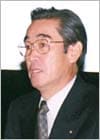[ 1st Half of fiscal 2001 Performance Briefing ]On the HDD head business
Yoshinori Hashimoto
Executive Director
General Manager of Data Storage Components Business Group
Let me start by talking about HDD heads. You should have some materials in front of you concerning this. but let me talk about our sales of these heads, which have a large impact on TDK as whole. Firstly, our initial interim forecast for head sales, announced in August, was 101.0 billion yen. The actual result, however, was 91.8 billion yen, 9% below our forecast. There were two main reasons for this performance, as Mr. Sawabe has just explained.
One was a poor production yield for new 15-gigabit/square inch HDD heads. Sales dropped sharply as we were unable to ship as many heads as we had originally planned. Secondly, unseasonable weather in August and September in Japan resulted in the stoppage of wafer lines, leading to a dramatic fall in production. Sales fell short of estimates by 9% as a result of these two factors. Please let me apologize for this result.
Turning to the second half of the current fiscal year, the effects of the delay in improving the yield of new heads still lingers. Furthermore, the steep drop in wafer production in September due to unseasonable weather has reduced shipments in early October. These factors have forced us to revise our sales estimate for the second half of the year to 82.2 billion yen, 6% less than our original forecast that we announced in August, which called for head sales of 93.0 billion yen.
I would now like to talk more about improving the yield, which has had a huge impact on sales. We recorded a double-digit decline in yield in the second quarter, compared to the first quarter. There were three reasons for the deterioration in the yield of new 15-gigabit/square inch heads. One was a problem concerning track width control. The second reason was a problem with dynamic characteristics. Thirdly, there was a problem with MR resistance control. Please let me go into each of these issues in a little more detail.
First there is the problem of controlling track width. That's because there are large fluctuations in a head's pole width, which determines recording density. Pole width is extremely narrow, normally between 0.2 and 0.3 microns. We must be accurate to within 0.02 or 0.03 microns. Thus, the deterioration in yields was caused by the fact that this precision formation technology had not been sufficiently refined when we began production of the new heads. To solve this problem, we have adopted a new control technique during wafer production to improve quality control. This technique is already in place, so we foresee significant improvements in the wafers we make from now on.
Second is the problem of the heads properties as it moves over the disk. As precision rises, the gap between the head and disk becomes smaller. This demands extreme accuracy in forming the head's surface. Basically, we need to make the head surface increasingly smooth as precision rises. While head surface unevenness is normally only about 2 nanometers, even this tiny amount of differences in height has now come to adversely influence head performance at recent levels of precision. Here, the problem lies with the head's structure, and this is where we made our improvements. We plan to have this improvement incorporated in heads that we make from December onward.
Third is the problem of controlling MR resistance, a specification that has an extremely great effect on a head's output. As recording densities rise, we require changes in MR resistance values that are increasingly "sharp." We have been experiencing problems because the fluctuations in MR resistance has been too large. We plan to reduce these fluctuations by introducing a new process, but we are experiencing delays in installing the new equipment. The result is lower yields. MR resistance is thus having a significant impact on yields. This concludes my discussion of sales and the relationship between sales and production yields.
Next, I would like to move on to TDK's position in the global HDD head market. First, we estimate that annual demand for HDD heads will be 621 million units this year. Last May, we were projection 600 million units. We have subsequently raised our estimate to 621 million units because of growth in HDD production. We expected that there would be an average of 3.2 heads used per HDD. However, small reductions in the numbers of heads used in HDDs for servers and 2.5-inch HDDs has led us to reduce our estimate to 3.1 heads per HDD. Regarding total demand and our market share, we estimate that total PC demand will be 138 million units and HDD demand will be 230 million, which translates into 621 million heads. Our plan was to use our acquisition of Headway Technologies to increase our share of the HDD head market. However, we have instead lost share. We estimate that our share will decline from 34% last year to 32% in the current fiscal year.
Regarding output capacity, the plan we announced last May remains unchanged. We expect to have a monthly output capacity of 27 million heads by the end of March 2001. We plan to increase capacity to 40 million units by the end of March 2004. Capital expenditures needed to achieve this growth remain the same as in our initial plan. This completes my remarks. Thank you for your attention.


